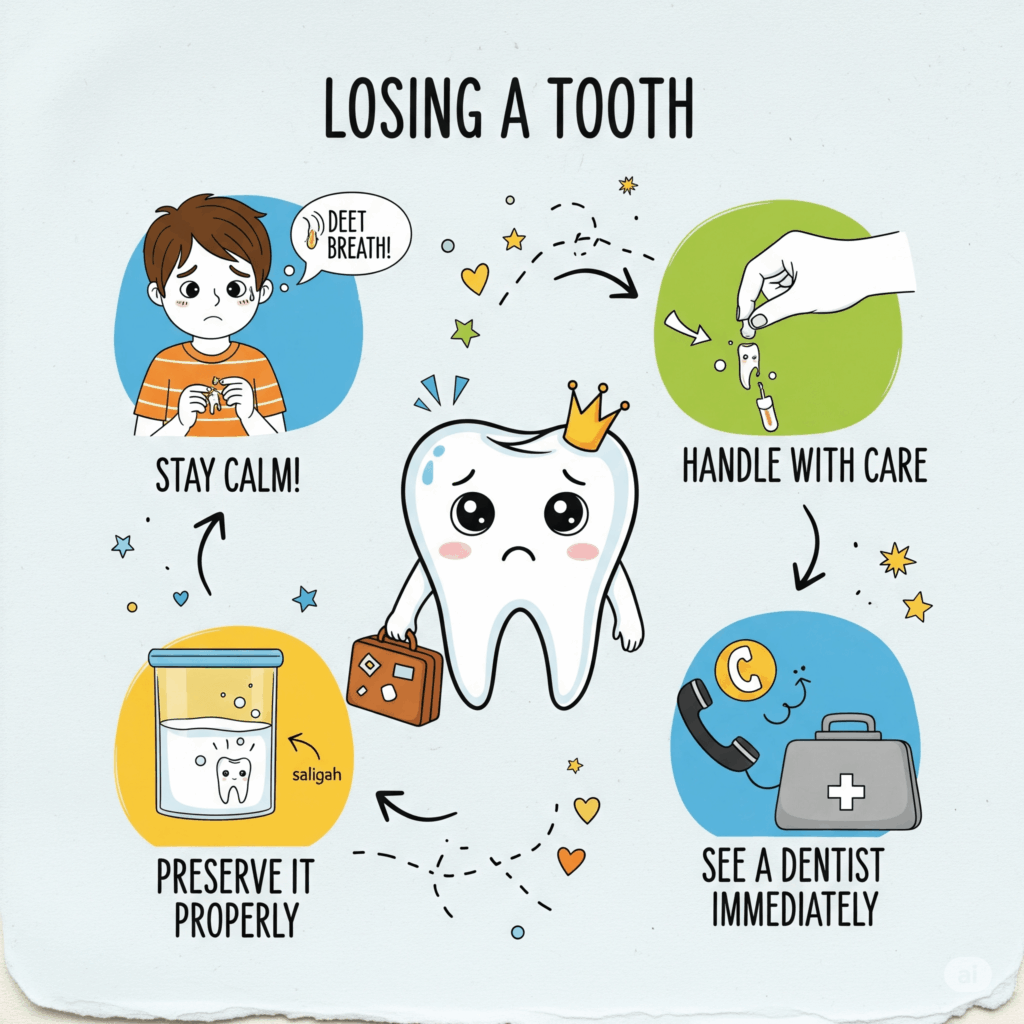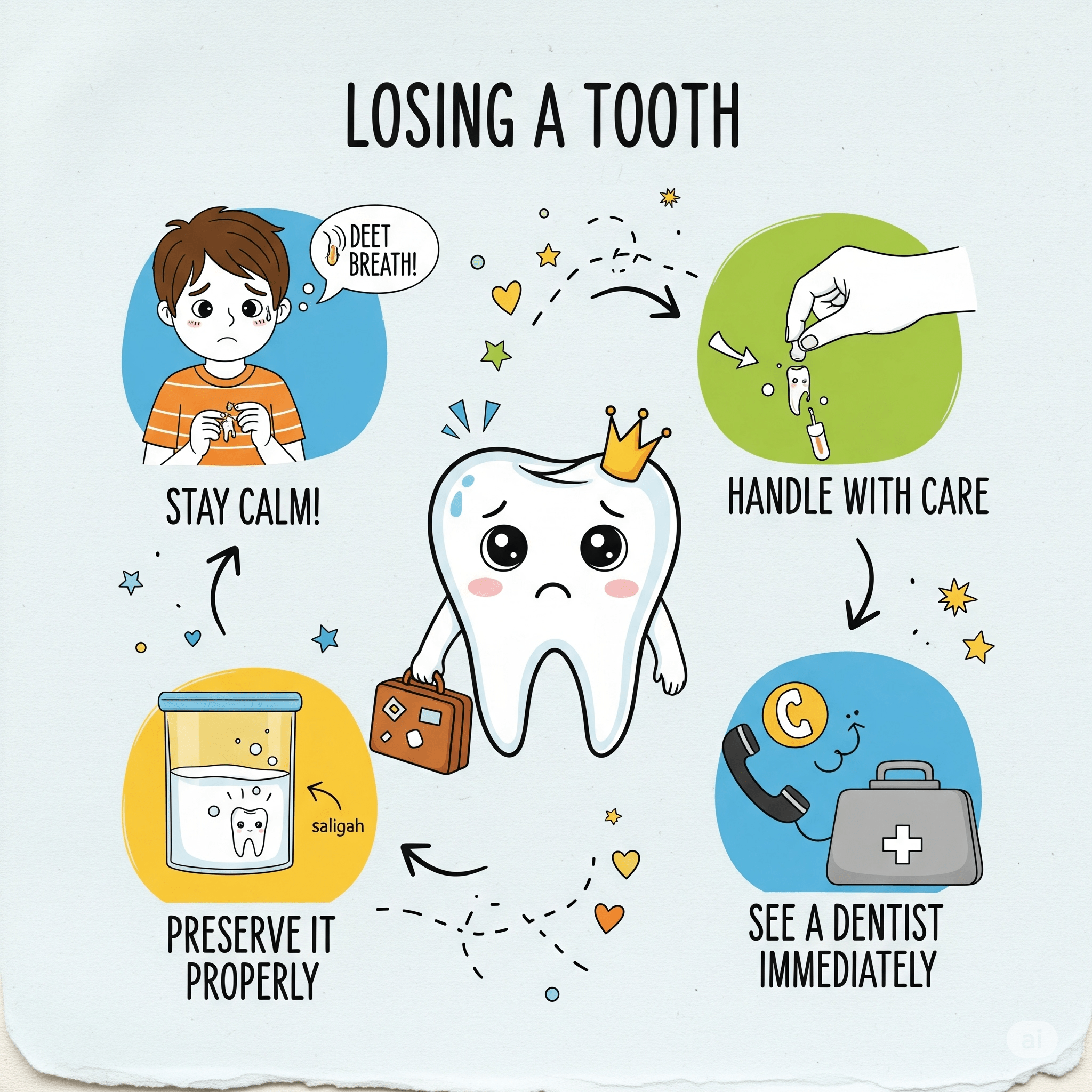
Losing a tooth unexpectedly is often a shocking experience, especially when it happens suddenly due to trauma or injury. Whether it’s caused by an accident, sports incident, or advanced dental disease, a lost tooth is more than just a cosmetic concern—it can impact your oral health, function, and overall well-being. For residents in Council Bluffs, IA, understanding the proper response is vital. Having access to educational resources like this blog, provided by BlueJay Family Dental and Dr. Steven Fidone, can make the difference between saving and permanently losing a tooth.
Understanding Why Teeth Fall Out
Losing a tooth can result from several different circumstances, each with its own implications for recovery. One of the most common causes of sudden tooth loss is trauma—such as being hit in the mouth during a sporting event or falling and landing on the face. This type of incident can cause the tooth to be completely knocked out, a condition known as avulsion. In this case, acting quickly is critical to improve the chances of reimplantation.
Another cause of tooth loss is advanced gum disease, or periodontitis. In these cases, the gums and supporting structures of the tooth deteriorate over time, loosening the tooth and making it more susceptible to falling out. Infections, untreated cavities, and even clenching or grinding teeth (bruxism) can weaken teeth over time, especially when combined with poor oral hygiene. Understanding the underlying cause can help guide proper treatment and prevent future occurrences.
Immediate Steps to Take When a Tooth is Lost
If you lose a tooth, time is of the essence—especially if the tooth is fully intact and could potentially be reinserted. The first thing to do is locate the tooth and handle it carefully. Always hold the tooth by the crown (the white part), never by the root. Touching the root can damage the delicate cells necessary for successful reinsertion.
Gently rinse the tooth with saline solution, milk, or clean water to remove any visible dirt, but avoid scrubbing or using soap. If possible, try to place the tooth back in its socket, ensuring it’s facing the correct direction. Hold it in place by gently biting down on a clean piece of gauze or cloth. If reinsertion isn’t feasible, place the tooth in a container with milk or saliva to preserve the root cells. The goal is to keep the tooth moist and protected. Ideally, you should seek emergency dental care within 30 to 60 minutes for the best chance of saving the tooth.
What Happens If the Tooth Can’t Be Saved
In some cases, the lost tooth may be too damaged or may not be located quickly enough to be reimplanted. If this happens, it’s important not to panic, but to understand the implications and next steps. Missing teeth can affect your ability to chew, speak clearly, and can even impact the alignment of surrounding teeth. When one tooth is lost, the nearby teeth often shift into the open space, creating bite issues and increasing the risk of further dental problems.
Long-term solutions are available for individuals who lose a permanent tooth. These options can help restore not only the appearance of your smile but also the function of your mouth. Depending on your situation, a dentist might recommend a dental bridge, a removable partial denture, or a dental implant. Each of these choices has different benefits, longevity, and suitability based on your oral health and budget. Consulting with a dental professional will help determine the most appropriate path forward.
Managing Pain and Preventing Infection
Pain and swelling are common after losing a tooth, particularly if the surrounding tissue or bone has been traumatized. To manage discomfort, over-the-counter medications like ibuprofen can help reduce inflammation and alleviate pain. Applying a cold compress to the outside of the mouth near the affected area can also minimize swelling and provide relief.
To prevent infection, it’s crucial to keep the mouth as clean as possible. Rinse gently with a saltwater solution and avoid smoking, which can slow the healing process. Eating soft foods and avoiding chewing on the affected side will help protect the area and reduce the risk of further injury. Watch for signs of infection, such as increasing pain, swelling, fever, or pus around the area. These symptoms indicate a need for prompt medical attention.
Long-Term Consequences of Ignoring a Lost Tooth
It may be tempting to ignore a lost tooth, especially if it’s not in a visible part of your mouth. However, doing so can have long-term consequences for both oral and overall health. When a tooth is missing, the surrounding bone can begin to deteriorate due to lack of stimulation, a condition known as bone resorption. This can affect facial structure and make future restorative procedures more complicated.
Additionally, the imbalance created by a missing tooth can strain other teeth, leading to uneven wear, jaw pain, and even temporomandibular joint disorders (TMJ). From a psychological standpoint, missing teeth can affect self-confidence, making social interactions and professional engagements more stressful. Taking steps to replace a missing tooth not only restores function but also preserves long-term dental health.
Prevention and Protective Measures
While not all instances of tooth loss can be prevented, many can be avoided with proactive care. One of the most effective preventive strategies is wearing a mouthguard during sports or other high-risk activities. Custom-fitted mouthguards offer superior protection by absorbing shock and reducing the risk of teeth being knocked out or broken during impact.
Maintaining strong oral hygiene habits is equally important. Brushing twice a day with fluoride toothpaste, flossing daily, and attending regular dental checkups help keep teeth and gums healthy. For individuals with gum disease or high cavity risk, more frequent cleanings and the use of antibacterial rinses may be recommended. If you grind your teeth at night, wearing a nightguard can protect your teeth from the excessive pressure that weakens them over time.
Emotional and Psychological Impact of Tooth Loss
Tooth loss isn’t just a physical issue—it often comes with emotional and psychological effects. People who have lost teeth may experience embarrassment, anxiety, or self-consciousness, particularly in social or professional settings. These feelings can affect self-esteem and quality of life. For children and teens, tooth loss can be especially challenging, impacting speech development and peer relationships.
Recognizing the emotional side of tooth loss is an important part of recovery. Seeking support, whether through conversations with a dental professional or speaking with others who have experienced similar situations, can help ease the transition. Restorative treatments, when sought promptly, can also contribute to renewed confidence and well-being, minimizing the lasting psychological impact.
Conclusion
Losing a tooth can be an unexpected and distressing event, but knowing how to respond can make all the difference in preserving your oral health. From immediate first aid steps to long-term restorative care, understanding your options is key to making informed decisions. In Council Bluffs, IA, having access to resources and professionals like Dr. Steven Fidone at BlueJay Family Dental can provide the guidance and care needed during such dental emergencies. Stay informed, act quickly, and don’t underestimate the importance of replacing a lost tooth to protect both your smile and your health.
Resources
Andreasen, J. O., & Andreasen, F. M. (2007). Textbook and Color Atlas of Traumatic Injuries to the Teeth. Wiley-Blackwell.
Kinane, D. F., & Stathopoulou, P. G. (2009). Periodontal diseases. Nature Reviews Disease Primers.
Mizrahi, E. (2007). The emotional impact of tooth loss in adults. British Dental Journal.

